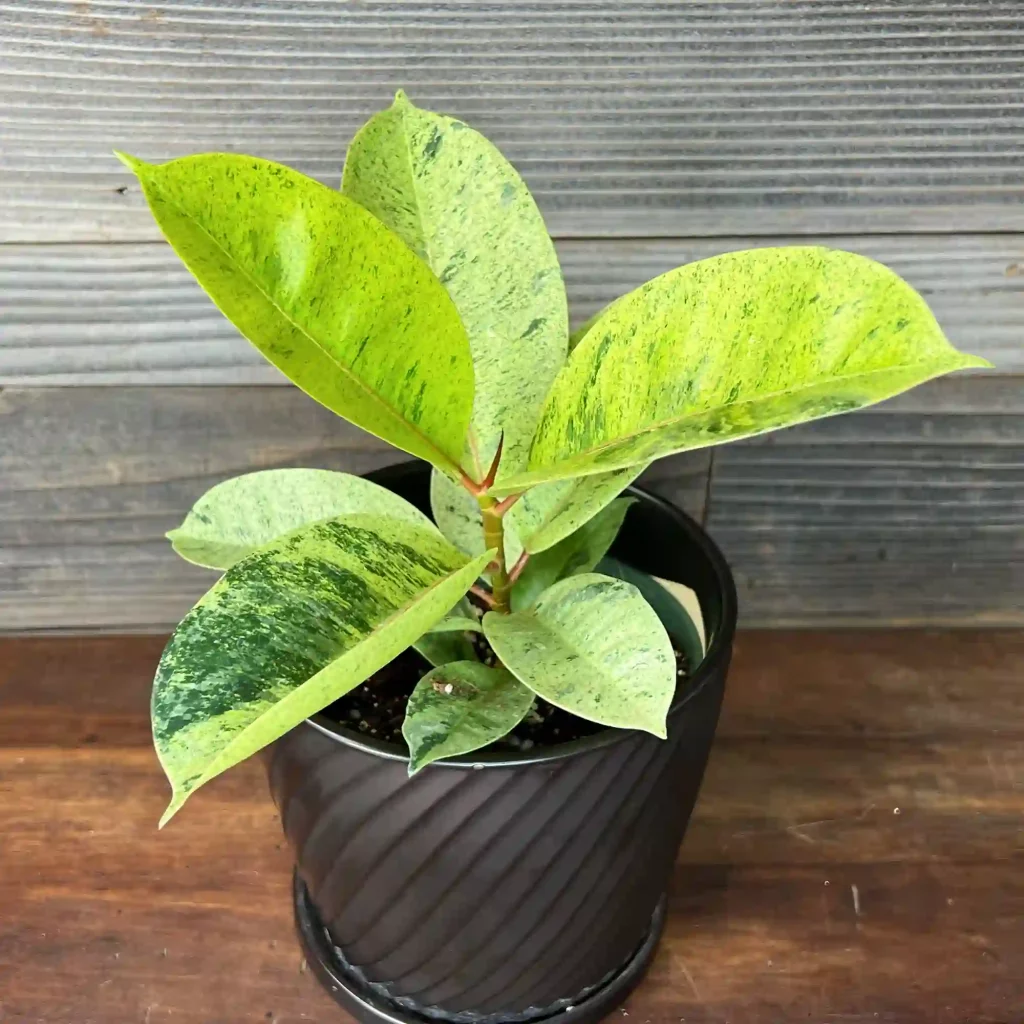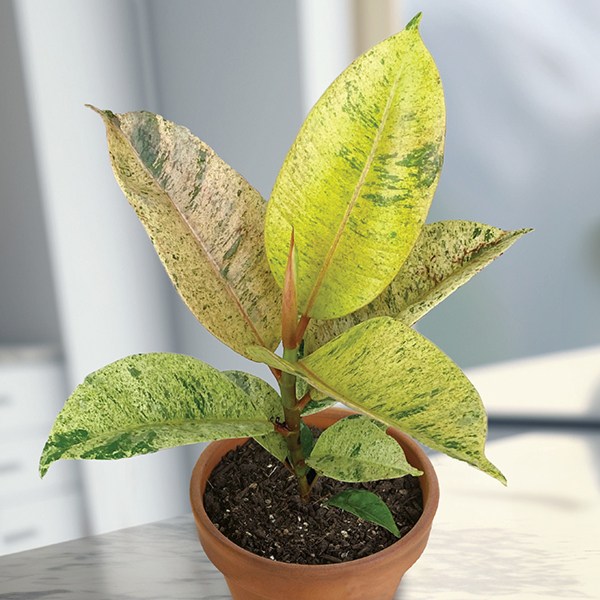Ficus Shivereana – An Overview
Ficus Shivereana, also known as Ficus elastica ‘Shivereana’, is a stunning hybrid rubber plant cherished for its vibrant, variegated foliage. Originating from the lush jungles of Southeast Asia, this rare houseplant features neon green or yellow leaves adorned with splashes of darker green, while its new growth often emerges in striking pink tones. While not as adaptable as its relative Ficus elastica, Ficus shivereana can thrive indoors in cooler climates with proper care. However, it’s important to note that Ficus shivereana is toxic to pets.
Facts about Ficus Shivereana
- Botanical Name: Ficus elastica ‘Shivereana’
- Common Name: Ficus shivereana, variegated rubber plant
- Native Area: Southeast Asia
- Plant Type: Evergreen, Shrub
- Family: Moraceae
- Sun Exposure: Partial
- Soil pH: Acidic
- Soil Type: Well-drained
- Mature Size: 6 ft. tall (indoors), 60 ft. tall (outdoors)
- Hardiness Zones: 10-12 (USDA)
- Toxicity: Toxic to dogs, cats, and horses

Care Guide for Ficus Shivereana
Soil Requirements
Ficus shivereana (Ficus elastica ‘Shivereana’) thrives in well-draining soil that retains some moisture but does not become waterlogged. A loose, porous potting mix rich in organic matter, such as a blend of peat moss, perlite, and coarse sand, is ideal. Additionally, ensuring proper drainage in the pot or container is essential to prevent waterlogging, which can lead to root rot. Avoid using heavy clay soils or compacted potting mixes, as they can hinder root development and cause issues with drainage. Regularly check the moisture level of the soil and water the plant when the top inch of soil feels dry to the touch.
Ficus shiveriana and Philodendron melanochrysum lies in their preference for high humidity levels. Both plants originate from tropical climates where humidity is abundant, making them ideal choices for indoor environments with consistent moisture levels. This shared characteristic underscores the importance of providing adequate humidity for their optimal growth and health, ensuring lush foliage and vibrant appearance.
In contrast, Rainbow elephant bush prefers lean, sandy soil that drains well and can tolerate drier conditions, reflecting its drought-resistant nature.
Temperature & Humidity Requirements
To optimize growth, maintain ficus shivereana in environments with a minimum of 50% humidity, akin to other tropical plants. Create a humid microclimate by situating it near other tropicals or utilize a humidifier for drier spaces. Rose painted calathea also thrives in temperatures between 60 to 80 degrees Fahrenheit, requiring similar conditions for ideal development.
Light Requirements
Place ficus shivereana in an area that receives medium to bright indirect light, avoiding direct sunlight. Brighter light levels aid in preserving the plant’s vibrant variegation.
Water Requirements
Instead of adhering to a fixed watering schedule, regularly monitor the soil moisture of your ficus shivereana to gauge watering needs. When the top half of the soil is dry, water the plant thoroughly, ensuring excess water drains through the bottom drainage holes. Check drip trays to prevent water accumulation, which may cause root rot. Increase watering frequency during the spring and summer months when the plant experiences faster growth, compared to the slower growth in winter.
Fertilizer
While ficus shivereana doesn’t require excessive feeding, it will benefit from occasional fertilization to encourage faster growth. Apply a balanced liquid houseplant fertilizer diluted to half strength once a month during the spring and summer. Discontinue fertilizing during the fall and winter seasons.
Pruning
Although ficus shivereana exhibits slower growth compared to a typical rubber plant, it can still reach heights of up to six feet indoors. When it starts to exceed your available space, you can trim back up to 25 percent of its growth at a time. Optimal pruning times are during the spring and summer when the plant is in its active growth phase, although you can also remove any occasional dead or damaged leaves as they arise.
How to propagate Ficus Shivereana?
Propagating a mature and healthy ficus shivereana can be done either in water or soil. The best time to propagate is during the spring and summer seasons. Here’s how to proceed.
Propagating Ficus Shivereana in Soil
Prepare for propagation by gathering sterilized shears, gardening gloves, a small plant pot, potting soil, and a clear plastic bag.
- Take stem tip cuttings from the mother plant, ensuring each cutting includes at least one leaf and one node by cutting just below a node.
- Allow the cuttings to callus over for approximately 24 hours.
- Fill the plant pot with moistened potting soil and create a hole in the soil surface using your finger.
- Plant the cuttings in the soil with the node positioned below the soil line.
- Place the cuttings in a warm area with bright, indirect light. Cover them with a clear plastic bag to maintain humidity. Keep the soil consistently moist but not waterlogged.
- Rooting typically takes three months or longer. Test for root growth by gently tugging on the cutting—if you feel resistance, roots have developed. Once new leaf growth appears, transplant the cuttings into individual pots and care for them as usual.
Propagating Ficus Shivereana in Water
Prepare for propagation by gathering gardening gloves, a small glass or jar, sterilized scissors or pruners, and water.
- Take a cutting from a stem tip, ensuring it has at least one leaf and a node, and make the cut just below the node.
- Allow the cuttings to air dry for about a day to facilitate callus formation.
- Place the cutting in the glass, ensuring the nodes are submerged in water while the leaves remain above the water line.
- Put the glass in a warm area with bright, indirect light, and replenish the water as needed to keep the nodes submerged.
- The cutting is ready for potting in soil when it develops several roots that are at least an inch long, which may take up to three months.
Common Pests & Plant Diseases
Monitor your ficus shivereana for common houseplant pests such as aphids, spider mites, and scale. If you observe any pests, take immediate action to eliminate them and prevent an infestation. Use a cotton swab soaked in rubbing alcohol or horticultural soap to remove pests effectively.
Common Problems With Ficus Shivereana
Growing ficus shivereana is straightforward with basic care and suitable conditions, but it’s important to remain vigilant for these common plant issues.
Curling Leaves
Monitor ficus shivereana for signs of leaf curling, which can result from either overwatering or underwatering. Assess the soil moisture and adjust watering accordingly: if the soil is dry, provide a thorough watering; if it’s wet due to frequent watering, reduce watering to allow the soil to dry completely before watering again. Moving forward, water the plant when the top half of the soil has dried out.
Brown Spots on Leaves
If light brown, dry spots appear on your ficus shivereana’s leaves, it may indicate sunburn due to excessive direct light exposure. If your plant receives direct sunlight, relocate it away from the light source or use a sheer curtain to filter the sunlight.




